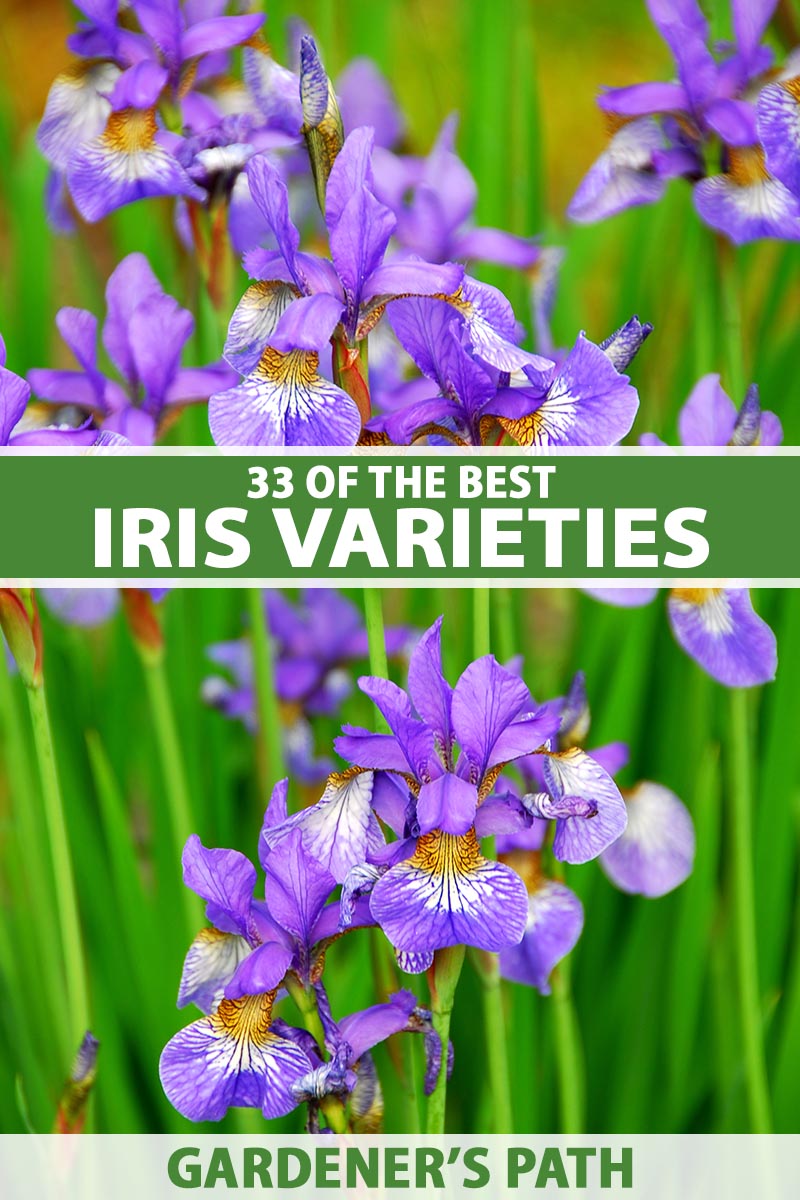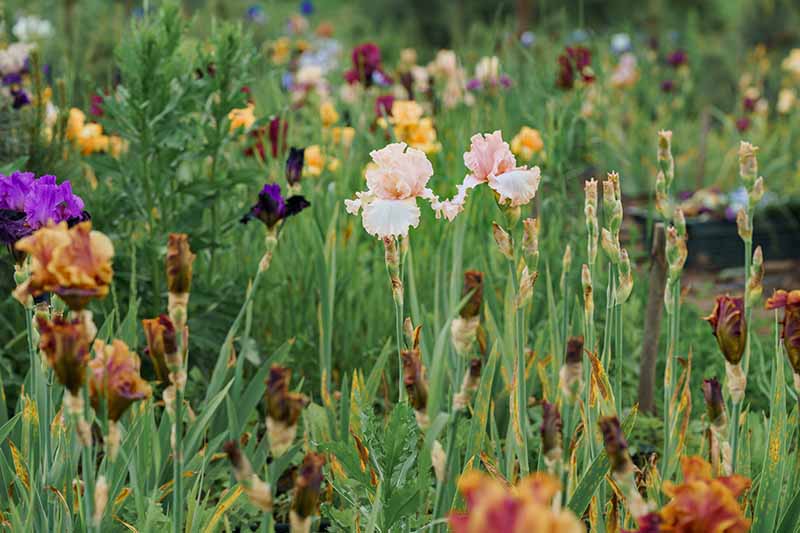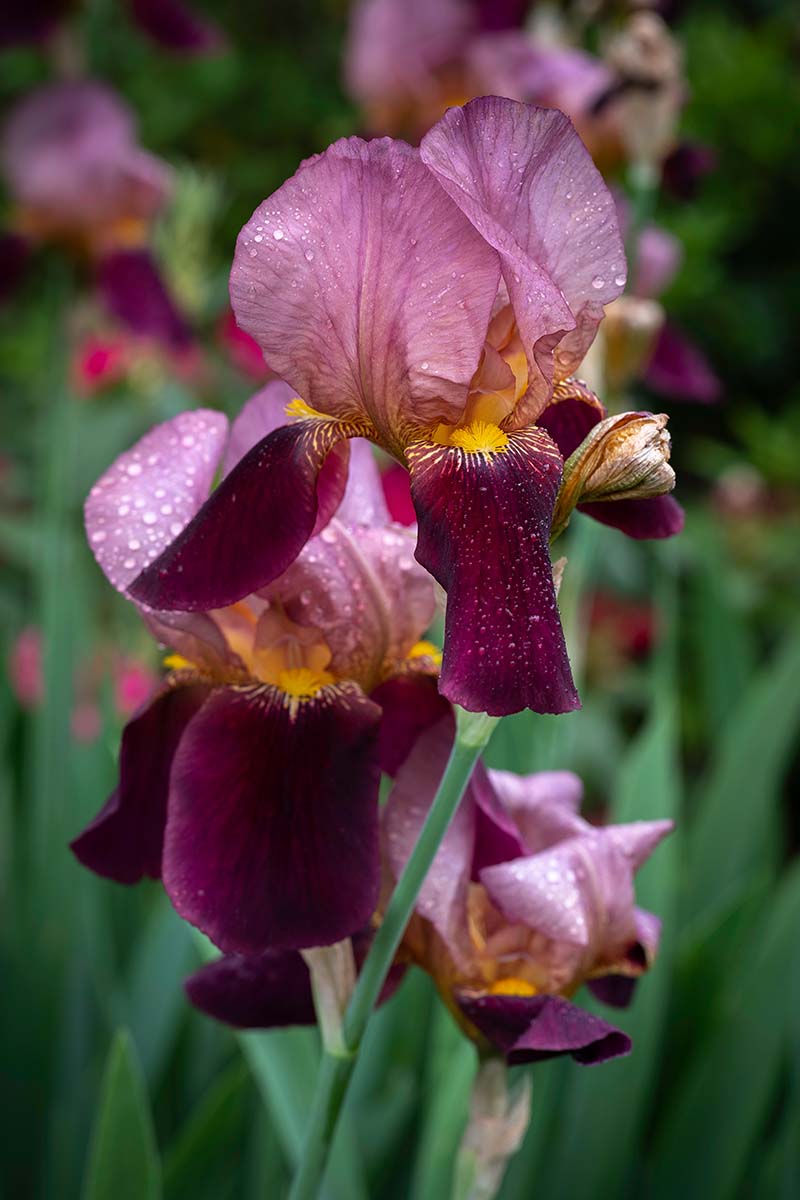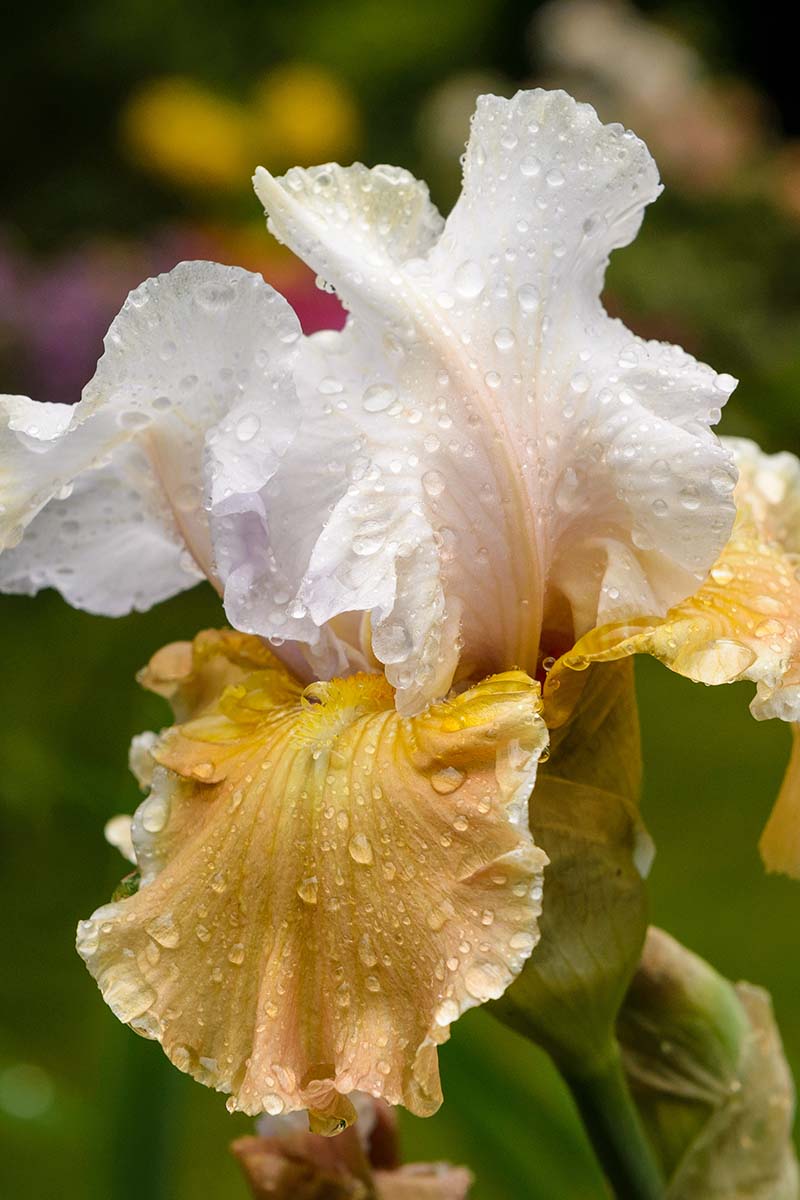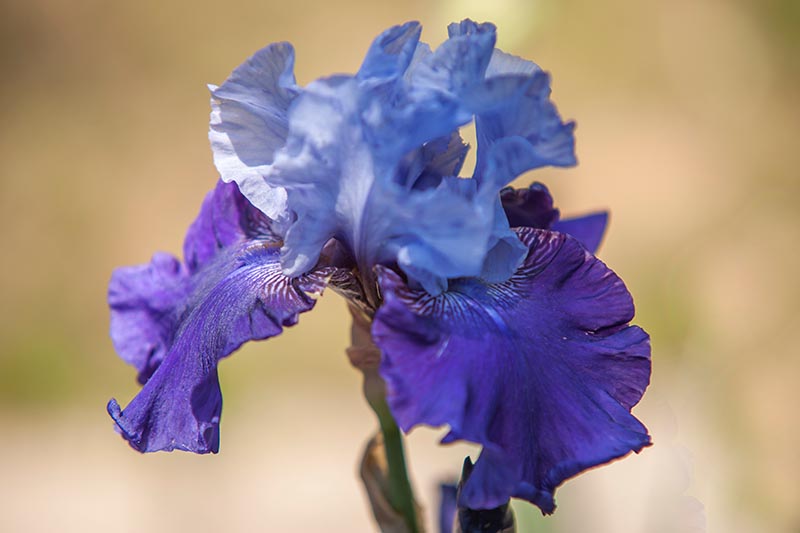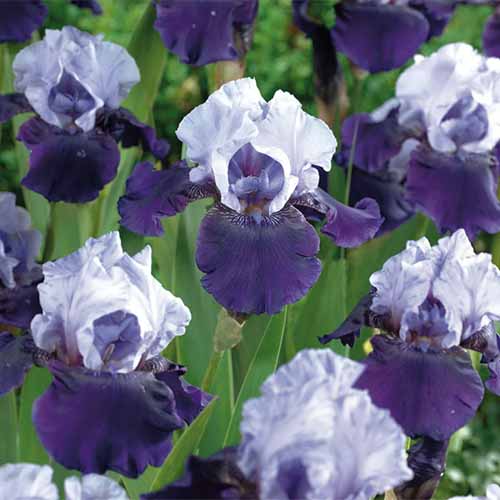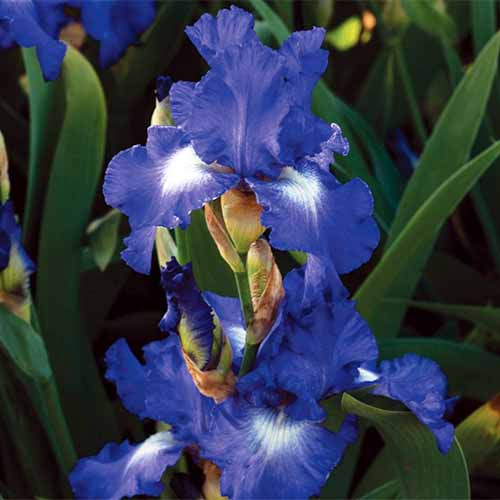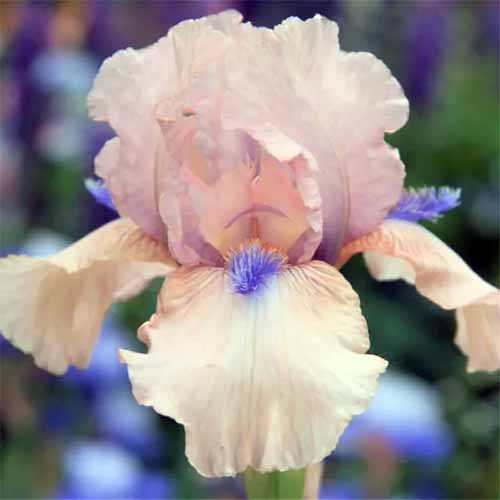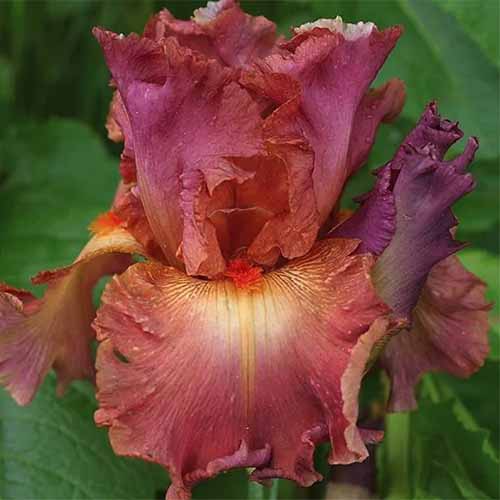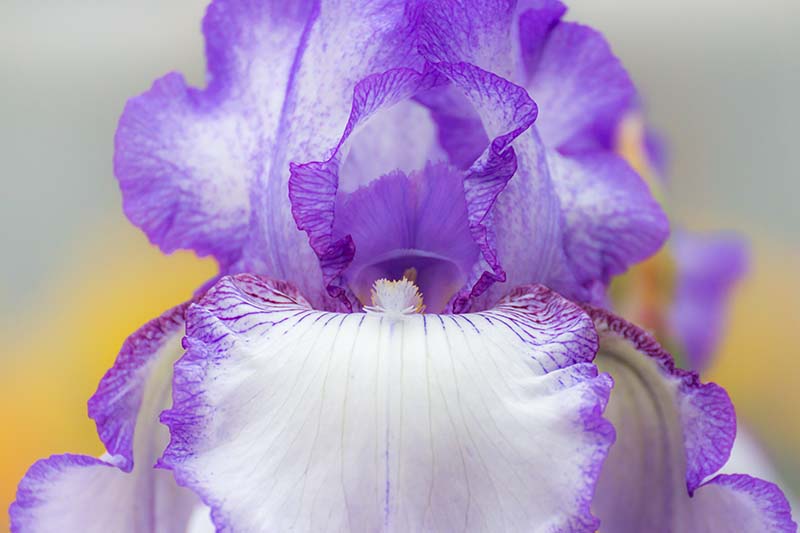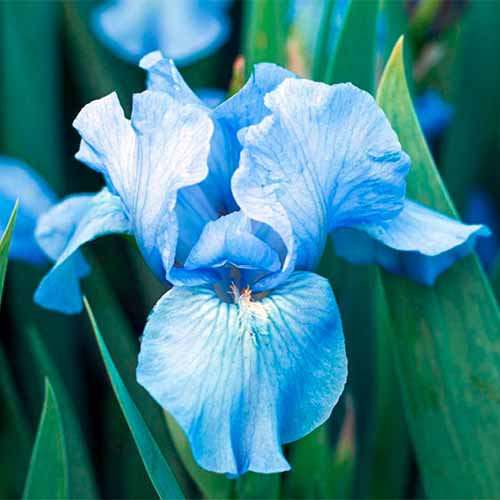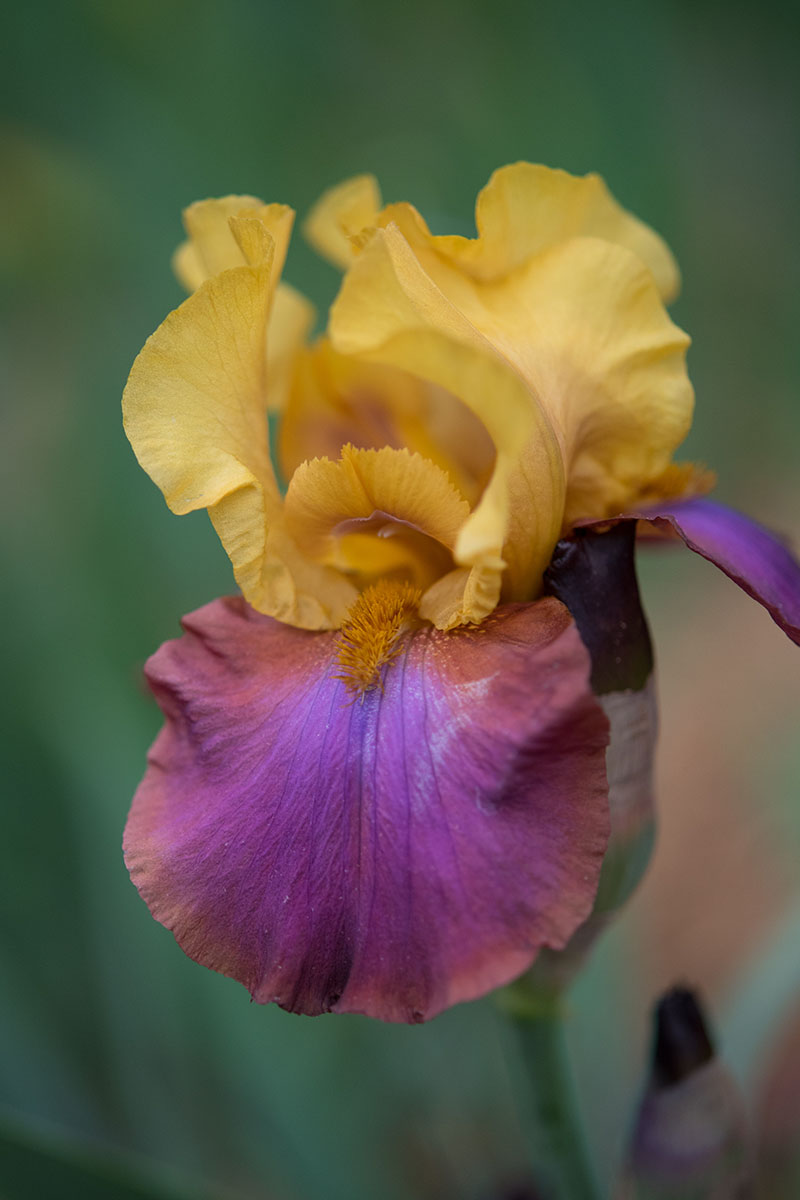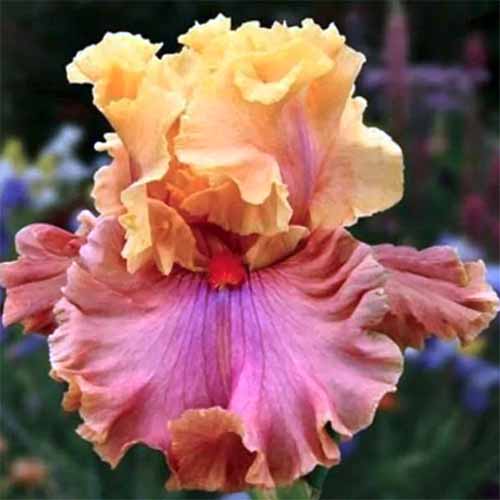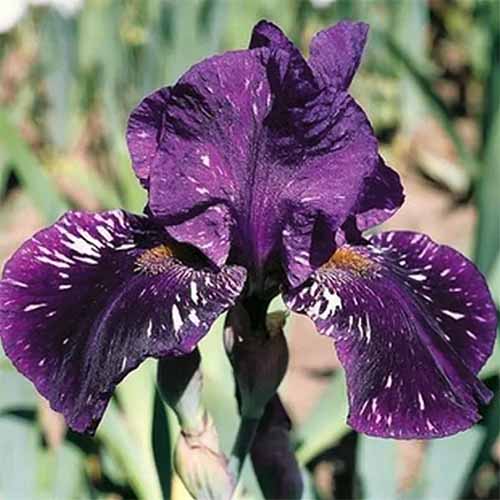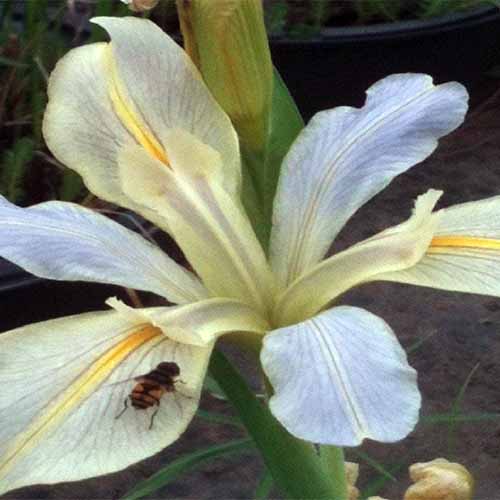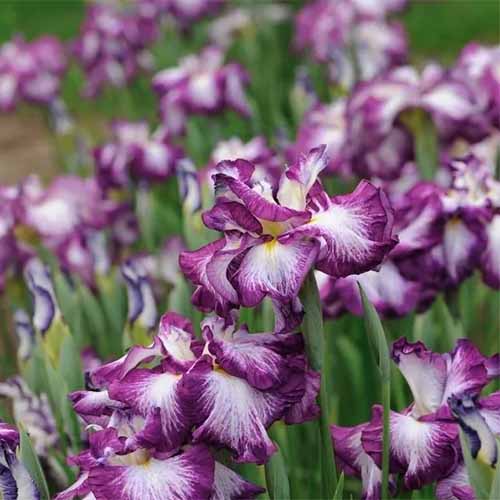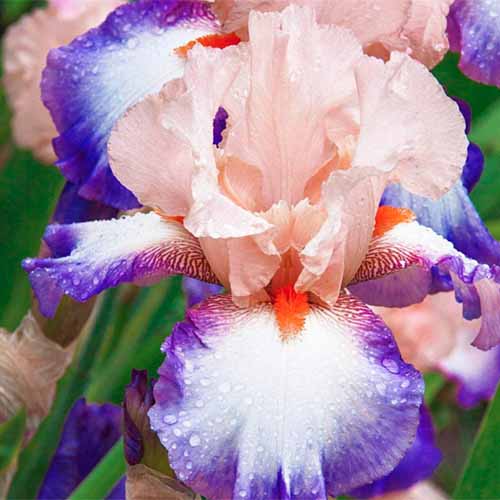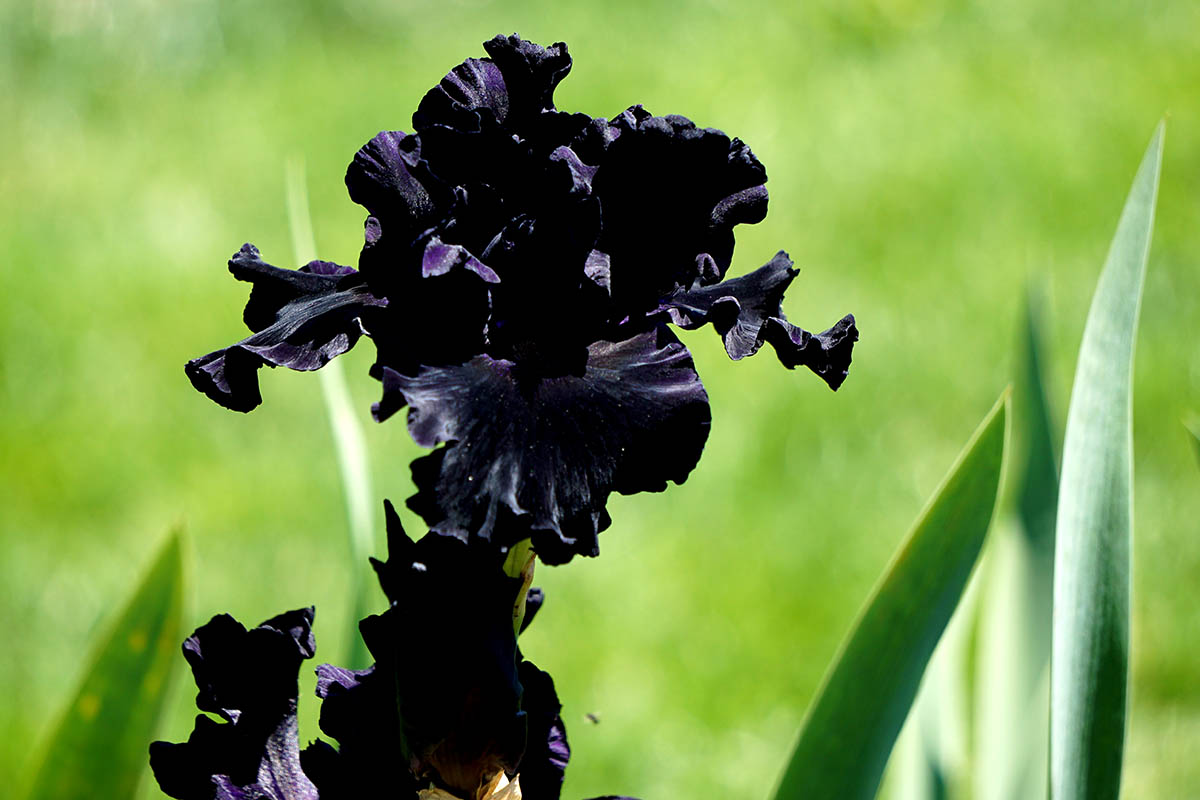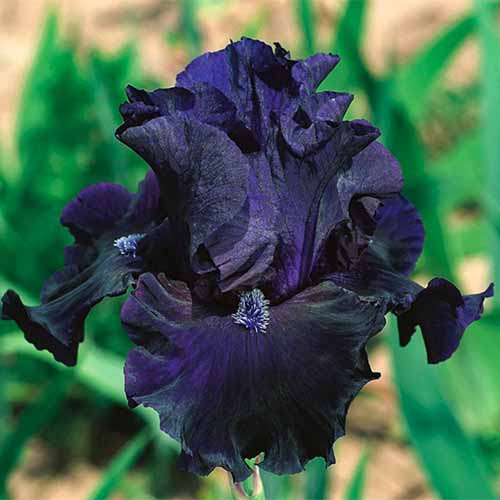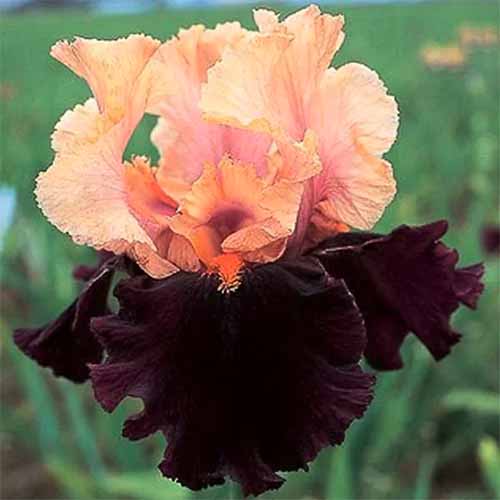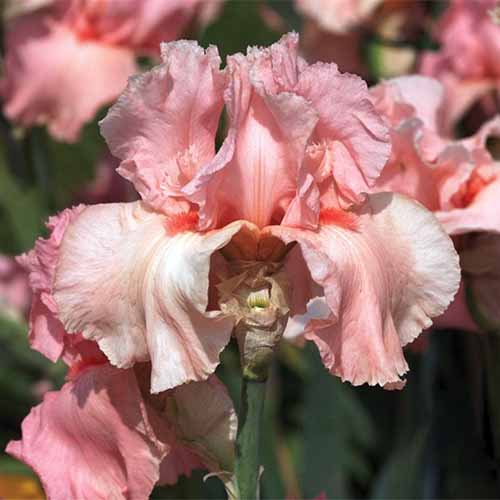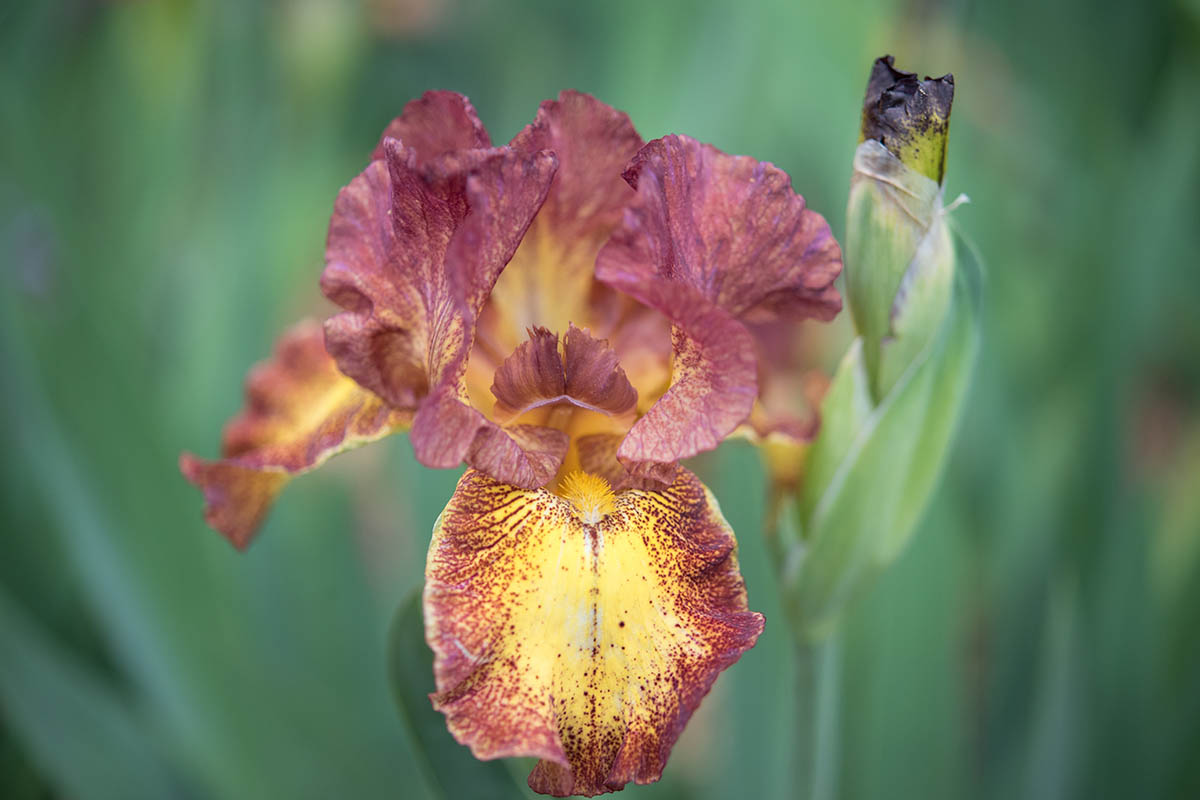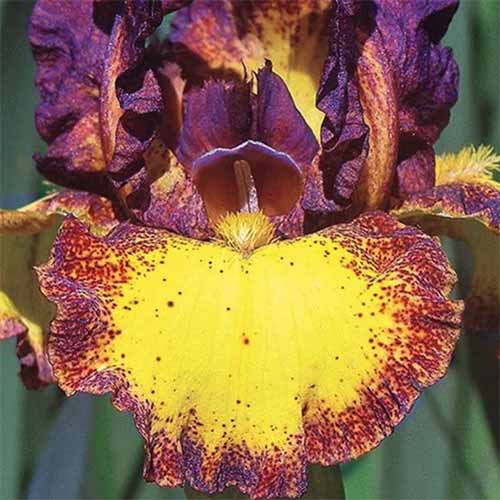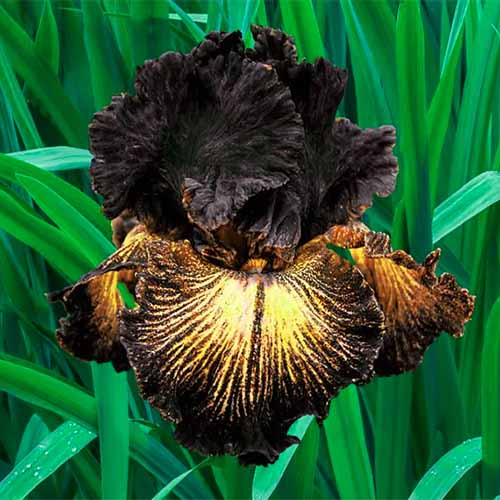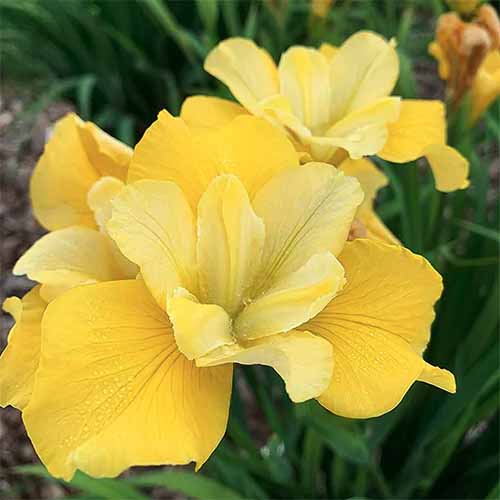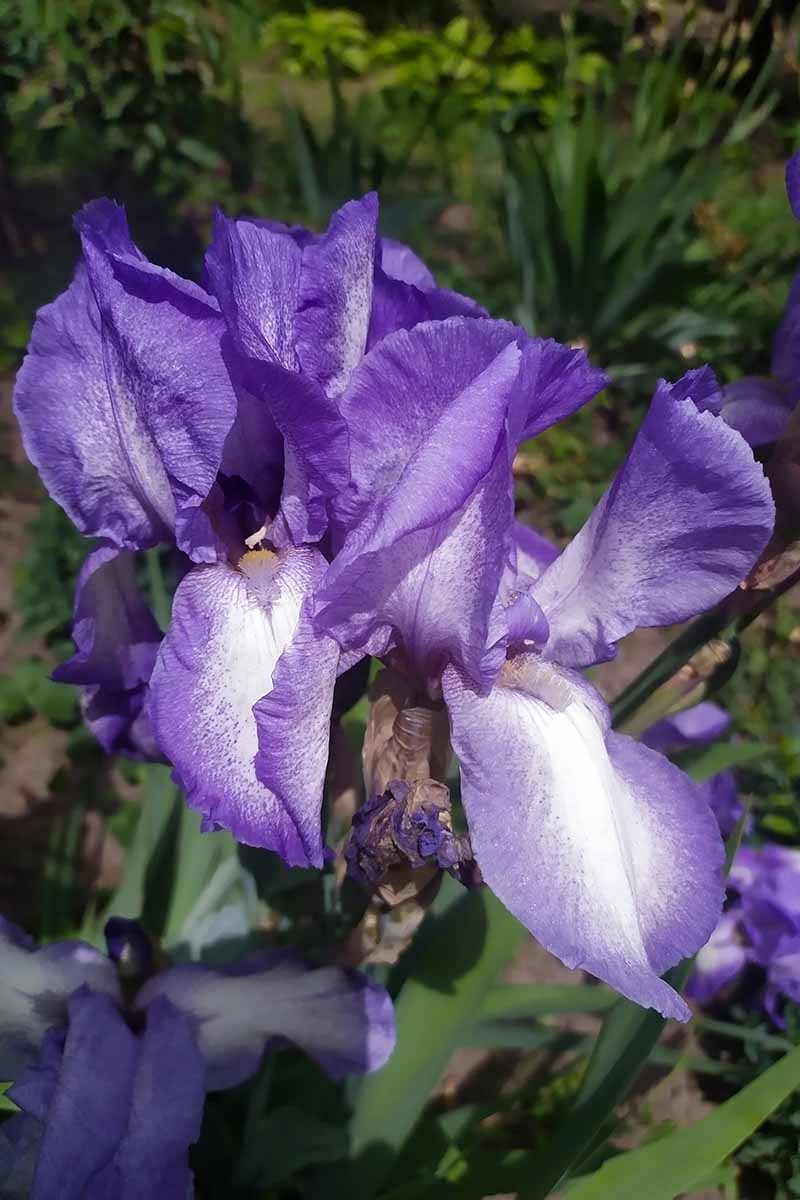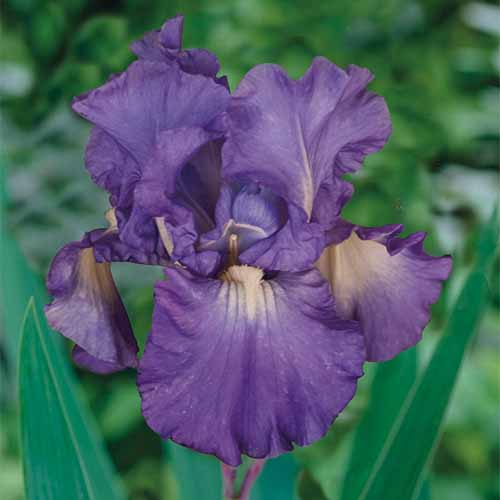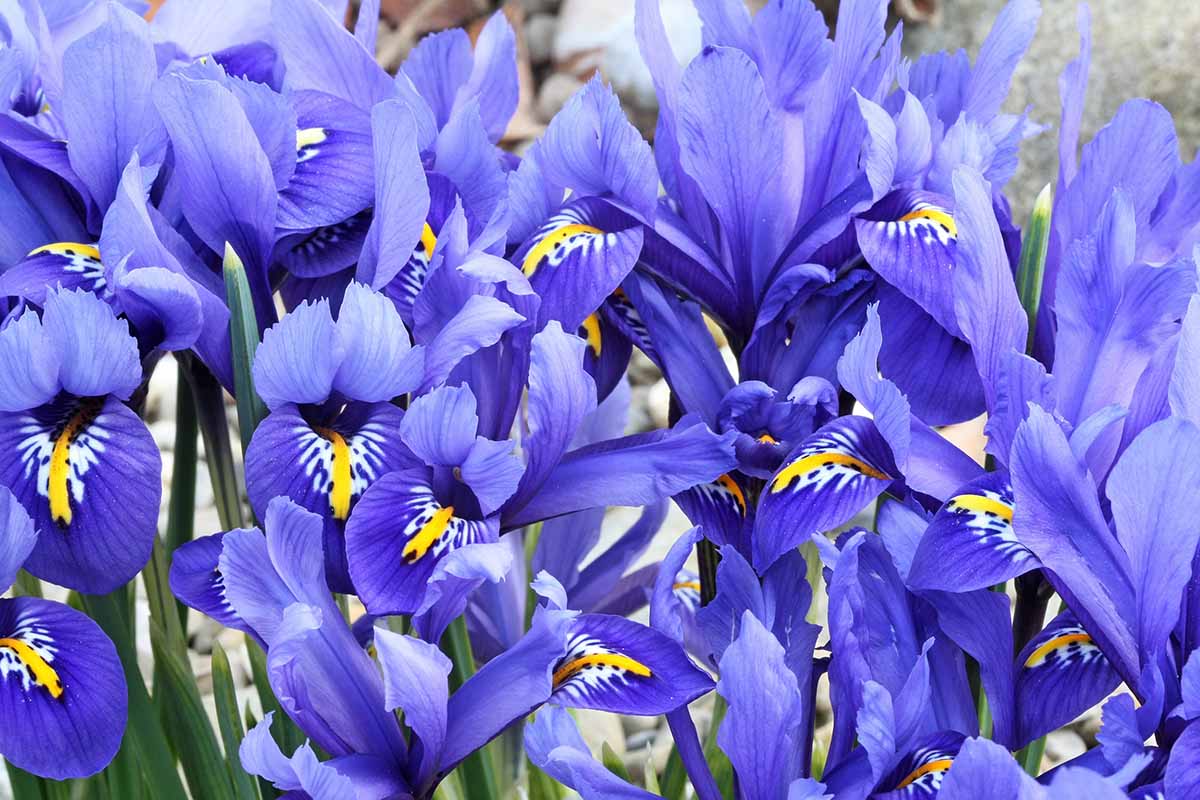First off, there are hundreds of species, with Dutch, Japanese, Louisiana, Siberian, and bearded being some of the most popular. Then, there are literally hundreds of cultivars and hybrids within these species. It’s enough to send you running out of the nursery in a panic. How can you possibly choose? We link to vendors to help you find relevant products. If you buy from one of our links, we may earn a commission. Here’s the lineup: It’s easy to love a plant that offers so much in so many different sizes and colors, but demands so little to grow it well. Get out your gardening journal or some scratch paper, and let’s narrow your choices down. Before we jump in, let’s clarify a few terms. Irises come in several different classifications and blooming sequences, and knowing what to expect ahead of time can help with your garden planning. There are bearded and beardless irises, which come in multiple sizes (tall, intermediate, dwarf), as well as aril and species (Japanese, Dutch, and so on) categories. These may be further classified as early, mid-, or late bloomers, as well as rebloomers. Rebloomers send out blossoms in the spring and again in the late summer. To learn all about the different iris classifications and their flowering sequence, check out our comprehensive guide. Next, you can group bearded irises of all sizes by their patterns. Patterns are a general description of how the coloring on an iris appears when the flower is mature. Keep in mind that there is no “official” standard for patterns. Instead, this is a way of grouping flowers to make it easier for growers and buyers to understand how a flower will look when in bloom. Bearded iris patterns come in amoena, orchid, bitone, reverse bitone, Emma Cook, self, plicata, variegata, neglecta, Debby Rairdon, blend, luminata, glaciata, broken, and line and speckles. Phew! You can learn more about iris flower patterns in our guide. (coming soon!) It also helps to know the parts of the flower so that you can envision how they’ll look in your garden. Irises have two types of petals. The first are the standards, which are the upright petals at the top of the flower. Then there is the fall, which refers to the three lower petals. The signal patch is a little colorful bit found at the center of the petals, just below the stigma, stamen, and beard, if one is present. The beard is a fluffy little finger that looks sort of like a caterpillar. It sits right on top of the falls, and you may find none, one, or multiple beards on each flower depending on the variety. If you’re new to growing irises, it might help to check out our guide to raising them before you jump in. Ready? Let’s take a tour of 33 favorite iris varieties for your garden.
1. Aachen Prince
This early-blooming, tall bearded iris was hybridized in 1986 and has been a popular option ever since. ‘Aachen Prince’ is a hybrid of ‘Flamingo Blues’ and ‘Firewater.’ It blooms for a long time, with dark blue flowers in a self pattern. At the center is a subtle orange signal. When mature, it reaches three feet tall.
2. Best Bet
‘Best Bet’ not only pops up early in the growing season but it’s a rebloomer, which means you can enjoy a colorful display for a long stretch of the year.
7. Definitely Different
Sometimes you wonder how breeders come up with their plant names, but with ‘Definitely Different,’ the reason is perfectly clear. The plant can grow up to three feet tall. ‘Best Bet’ Home Depot carries packs of three rhizomes of this elegant stunner, available for purchase online.
3. City Lights
‘City Lights’ is a classic-looking tall bearded iris with deep violet petals that have a faint white patch surrounding the beard. The signal patch is pale yellow. Introduced in 1991, it’s a hybrid of ‘Fancy Face’ and ‘Windsurfer’ that reaches just over three feet tall. It’s a self-patterned rebloomer with large flowers that last a long time. ‘City Lights’ Sound good? Head over to Home Depot to grab a set of three rhizomes for your garden.
4. Champagne Elegance
Raise a glass to this iris that resembles a frothy flute of champagne. If you’re looking for a bicolored type that stands out from its blue and purple peers, ‘Champagne Elegance’ is an excellent option. The pale pink standards rise above pastel apricot falls on a 32-inch-tall plant. ‘Champagne Elegance’ This rebloomer was introduced in 1987, and it received an honorable mention from the American Iris Society (AIS) in 1989, as well as their Award of Merit in 1991. Eden Brothers carries this tall bearded iris that’s worth celebrating in packs of two, four, and 10 rhizomes.
5. Concertina
This orchid-patterned rebloomer will have you dancing to its song as it shows off its big blossoms. An intermediate bearded iris, ‘Concertina’ tops out at just over two feet but the blossoms themselves are huge, reaching up to six inches across. While the coloring is soft and pastel, it makes a bold statement in the garden. Each petal is a pale rose with a dark violet and orange beard at the center. ‘Concertina’ This hybrid of ‘Aaron’s Dagger’ and ‘Chanted’ was introduced in 2000, and it won the AIS Award of Merit in 2006. Hearing the siren song of ‘Concertina’? Grab yourself a plant in a #1 container at Nature Hills Nursery.
6. Dame de Coeur
An elegant three-foot-tall lady of the garden, ‘Dame de Coeur’ will easily capture your heart. A tall bicolor bearded iris, the petals are vibrant raspberry pink contrasted against a striking tangerine beard. The falls have subtle orange highlights at the top, as well. ‘Dame de Coeur’ Flowering happens in the mid- to late-season, and the gray-green foliage adds its own interest to the garden when it’s not in bloom. A hybrid between ‘Good Show’ and ‘Rougissant,’ it does best in partial shade. Want to invite this lady to your garden? Nature Hills Nursery carries her in packs of three rhizomes. This plicata-patterned cultivar has all the familiar coloring, including yellow, purple, and white, but that doesn’t mean it’s your typical iris. The standards on this tall bearded type are bright white with a distinct golden outline. Below, the falls are outlined in tangerine with a lilac and white center. The beards are vibrant tangerine, and the haft veins – which extend out of the center of the falls on the top third of the petals – are deep russet. The flowers stand like colorful flags on 38-inch-tall plants. This beauty is a hybrid of ‘Spring Satin’ and ‘Goldkist,’ and it was introduced in 2002. In 2004, it received an honorable mention from the American Iris Society.
13. Hall of Marble
‘Hall of Marble’ is a Japanese iris, and its beauty can’t be captured by mere words. You have to see it to understand how gorgeous it is. It’s a tall bearded type that reblooms reliably. On top of the bold white and lavender coloring, the petals are highly ruffled, and you can easily see their resemblance to the ruffles on an Elizabethan ruff. Each plicata-patterned petal is outlined in dark lavender with bright white centers and lavender veins. The beard is the palest orange with pale violet at the tip. ‘Earl of Essex’ was introduced in 1980, and it grows to three feet tall. ‘Earl of Essex’
9. Forever Blue
For those spots in the garden that could use a smaller plant, ‘Forever Blue’ fits the bill. This is a dwarf bearded iris that tops out at just 12 inches, but it’s not short on color. A self-patterned rebloomer, it has pale lavender petals with dark veins and deep lavender beards. A small orange and wine-colored signal patch adds just a little bit of extra depth. ‘Forever Blue’ Introduced in 1997, it quickly nabbed an honorable mention in 2000 and the Award of Merit in 2002 from the American Iris Society. Home Depot carries single bare root plants for sale.
10. Gala Madrid
‘Gala Madrid’ has been around since 1967, which is much longer than many of the plants on this list. There’s a reason for that. This cultivar received an honorable mention in 1969 and won the Award of Merit in 1971 from the American Iris Society. It has proven to be a reliable, sturdy option. The variegata-patterned plant has deep butterscotch yellow standards, while the falls are dark reddish-purple with a blue signal. The falls are outlined in Bordeaux red with an orange beard. The falls feature subtle dark purple veins, and all of the petals are heavily ruffled. This tall bearded iris reaches about 30 inches in height and blooms late in the season. It’s a hybrid of ‘Main Event’ and ‘Gypsy Lullaby.’
11. Glamazon
This tall bearded iris is so flashy that it could easily compete with the rest of the queens on RuPaul’s Drag Race. ‘Glamazon’ is new on the scene, introduced in 2007, but she started turning heads right away with her heavily ruffled petals. The standards are butterscotch and the falls have a soft butterscotch undertone with a bold rose overlay. The blaze is tangerine and red, and the signal is blue-purple. ‘Glamazon’ ‘Glamazon’ is a bicolor late bloomer that comes from the House of ‘Glamour Pants’ and ‘Decadence’ (or in other words, it’s a hybrid of the two). As RuPaul sings in her song of the same name, “everybody wants her, she’s like a female phenomenon.” If you want her on your garden runway, Nature Hills Nursery can make your dreams come true with a bare root plant. ‘Glamazon:’ Shantay, you stay. Can I get an amen?
12. Gnu Again
The old familiar purple iris is made new again with this speckled stunner. This tall bearded type has ruffled, intensely purple falls and slightly lighter standards. Both are covered in bold white speckles, all on a three-foot-tall plant. ‘Gnu Again’ Introduced in 1994, ‘Gnu Again’ quickly nabbed the AIS Honorable Mention two years later. In 1998, it took home the Award of Merit. To add something new to your garden, purchase a plant at Nature Hills Nursery. The petals have a purple-blue base that fades to true purple on the exterior. Throughout are stripes and streaks of white, all anchored by a bright yellow splotch in the center of each petal. This lines and speckles-patterned water iris was introduced in 1956. It’s an extremely tall plant, stretching up to four feet in height when mature.
14. Haunting
Black flower gardens have become incredibly popular these days, but it’s hard to find flowers that have truly deep, dark coloring. But the tall bearded iris known as ‘Haunting’ fits the bill. The petals have an extremely dark violet-red base with an overlay of black. This 36-inch-tall plant can be a bit challenging to find, but it’s worth seeking out. Not only does it have true black in the petals, but it’s hardy, and the coloring is reliable so it won’t fade in the shade. Not all black plants can claim this. It’s also a self-patterned rebloomer, with the second flush popping up in the late fall. Both the standards and falls are magenta, as is the signal and the beard. If you open the throat of the flower up, you can see some bright yellow deep down inside, but it’s not apparent from the exterior. ‘His Royal Highness’ Introduced in 1989, it’ll be an instant classic worthy of the throne in your garden. Eden Brothers carries packs of two, four, or 10 bulbs of this self-patterned plant.
16. Innocent Star
In 1999, this tall bearded type hit the scene, with beet red standards and white falls edged in lavender. At the center is a splotch of yellow with a cream base, bluish-purple veins, and a red beard. A hybrid of ‘Innocence Abroad’ and ‘Rock Star,’ it grows three feet tall with gracefully ruffled plicata blossoms. ‘Innocent Star’ Adding this superstar rebloomer to your garden is a no-brainer. Snag a bag of two, four, or 10 bulbs at Eden Brothers.
17. Invitation
Irises are known for their bold coloring, but sometimes you want something a bit more subtle. Enter ‘Invitation.’ This 34-inch-tall amoena patterned tall bearded iris is resplendent with blush pink standards and pale apricot falls. The beard is a dark tangerine. ‘Invitation’ If you want to invite this sweet treat to your garden, stop on over at Eden Brothers for a bag of two, four, or 10 bulbs.
18. Just for Sophie
‘Just for Sophie’ is a tall bearded type in the palest shade of apricot. Both the standards and falls are pale apricot with darker apricot veining, and the falls have a subtle ombre effect with slightly darker tips. This reverse bitone mid-season bloomer received an honorable mention from the AIS in 2001, just three years after it was introduced.
19. Lavender Sunrise
Bearded irises are marvelous and all, but if you’re hoping to fill a soggy spot or a part of your backyard pond, you need to turn to the types that like to grow in heavy moisture. Of those, ‘Lavender Sunrise’ is a particularly lovely option. ‘Lavender Sunrise’ Where most Louisiana irises are fairly vibrant, this one looks more like a watercolor. The leaves are pale lavender and white, with pale yellow stripes down the centers of the petals. Plants top out at about 30 inches, though they usually stay smaller. Head to Home Depot to grab yourself a live plant in a four-inch container.
20. Lion King
‘Lion King’ is wildly popular, and for a good reason. This Japanese cultivar grows up to 40 inches tall and blooms in mid-season, but that’s not why it roars head and shoulders above the rest. The petals are sword-shaped and white with dark purple, heavily ruffled edges. In the center of each petal is a bright orange-yellow signal. Introduced as a hybrid between ‘Frosted Pyramid’ and ‘Frilled Enchantment’ in 1996, it has been capturing the attention of garden visitors ever since, and is now one of the most popular Japanese hybrids out there. ‘Lion King’ It won the AIS Honorable Mention in 1999, the Award of Merit in 2001, and the W. A. Payne Medal in 2003. Make room for a pride of these irises, because they reproduce readily without becoming invasive. To start, visit Nature Hills Nursery to pick up a live one in a #1 container.
21. Lumarco
With pale rose standards and white falls edged in deep purple, ‘Lumarco’ demands attention. The bright orange beard and red veins on the top edge of the falls only add to the attraction. A tall bearded iris, ‘Lumarco’ grows up to about 33 inches, and blooms in mid-season with its showy Emma Cook pattern. ‘Lumarco’ It’s no wonder, if you decide you want to add this to your garden. To make it happen, head to Home Depot to pick up individually packaged bare root plants.
22. Obsidian
‘Obsidian’ has earned a reputation among black flower lovers for being one of the truest purple-black flowers you can grow. A tall bearded type, the overall color is deep grape purple with slightly lighter standards. All of the petals are washed in black, particularly at the tips. Even the beard is black and grape purple. There is a splash of yellow deep in the throat of each blossom, but you can’t see it from the outside. This self-patterned dark beauty made a splash when it debuted on the market in 2002, and it earned the AIS Honorable Mention in 2004 and the Award of Merit in 2006. ‘Obsidian’ Whether you have a black flower garden or you just want to add a dark contrast to the rest of your plants, you can’t beat ‘Obsidian.’ Home Depot carries bare root plants.
23. Ocelot
It might not resemble the feline of the same name, but talk about a contrast! ‘Ocelot’ features pale peach standards and incredibly dark maroon falls. They’re so dark, in fact, that they look black in a certain light. The bicolor petals are ruffled, and the flowers emerge in the early- to mid-season on 36-inch plants. A hybrid of ‘Chinese New Year’ and ‘Romantic Evening,’ ‘Ocelot’ hit the market in 1998. ‘Ocelot’ This bicolor type took home the AIS Honorable Mention in 2000, and the Award of Merit in 2002. Nature Hills Nursery can help you bring ‘Ocelot’ home.
24. Peacock Butterfly Uncorked
The bearded ladies garner all the attention, but Siberian irises can be extremely stunning, as well. Take ‘Peacock Butterfly Uncorked.’ It’s a flashy bloomer, with bright yellow falls covered in reddish-purple veins and margins. ‘Peacock Butterfly Uncorked’ The standards are lavender and smoky gray with dark purple veins. Plants top out at about 26 inches. Head to Burpee to bring home your own showy display. This cultivar is available in packs of three bare root plants.
25. Pink Attraction
‘Pink Attraction’ is aptly named. It has self-patterned pale pink petals with just the faintest hint of violet below the beards, which are orange. While many irises have a pleasant scent, this one delights the nose with an intense, sweet fragrance. ‘Pink Attraction’ This tall bearded hybrid of ‘Jean Guymer’ and ‘Vanity’ was introduced in 1988. It’s a reliable rebloomer with highly ruffled petals on a three-foot-tall plant. Grab a pack of three bare root plants at Home Depot.
26. Pink Parfait
Irises are known for their distinct shape, but this Siberian cultivar defies the standard. Its ruffled petals look more like those of a peony or a rose. Each petal is pinkish-lavender with a splotch of pale pink or white near the tips. It averages about two feet tall, but can grow a bit taller. ‘Pink Parfait’ By the way, don’t confuse this plant with its relative, the Pacific Coast iris ‘Pink Parfait.’ That one is an entirely different species with pale pink petals that have a dark purple and yellow center. To add three bare root plants to your yard, pop on over to Burpee.
27. Red Ember
This Dutch cultivar will set your heart on fire with its flaming red falls and violet standards. The signal is striking yellow-orange and the petals have faint veins throughout. ‘Red Ember’ This plant will grow to about 20 inches tall, and blooms in mid-season. Buy 15 bulbs of this gorgeously glowing plant at Burpee.
28. Red Hot Chili
We hope you like it spicy, because ‘Red Hot Chili’ brings the heat. The standards have a bright yellow center with a deep, russet red wash overall. The falls have a broader yellow center and speckled russet margins, all highlighted by a bright yellow beard. Speaking of beards, this is an intermediate bearded cultivar with a plicata pattern that grows to 18 inches tall. A hybrid between ‘Ruby Eruption’ and ‘Rock Star,’ it was introduced in 2008, and won the AIS Honorable Mention in 2011, the Award of Merit in 2014, and the Hans and Jacob Sass Medal in 2017. ‘Red Hot Chili’ Oh, and in case you were curious, it absolutely does have a spicy, floral scent. Nature Hills Nursery carries this stand-out cultivar.
29. Sapphire Jewel
To add a touch of sparkle in precious jewel tones to the garden, look no further than ‘Sapphire Jewel.’ A dwarf bearded iris, it stays under 12 inches tall, but it isn’t short on color. It blooms all season long with blue-violet petals that are so vibrant they appear to shine from within. The base of the self-patterned petals are darker violet, as are the beards. ‘Sapphire Jewel’ was introduced in 1978 and earned the AIS Honorable Mention in 1980, the Award of Merit in 1982, and the Cook-Douglas Medal in 1984.
30. Sorbonne
We’re not talking about the school in Paris, here. Instead, we’re singing the praises of the fantastic tall bearded cultivar with bubble ruffled petals in brown, black, yellow, gold, and red. Topping out at 38 inches, the standards are brownish-black with a hint of red on the edge, and a speckled golden-yellow center. The beard is white with a brown tip. ‘Sorbonne’ After being introduced in 2009, ‘Sorbonne’ made the grade when it brought home the AIS Honorable Mention in 2011, and the Award of Merit in 2013. Nature Hills Nursery lets you bring this unique plicata-patterned flower home.
31. Sunfisher
If you wish you could fish a little sun out of the sky and plant it in your garden, look no further than ‘Sunfisher.’ A Siberian iris, it blooms in the early to mid-season on a 28-inch-tall plant. The standards are pale yellow, contrasting nicely with the deep yellow falls. ‘Sunfisher’ Head to Nature Hills Nursery to wrangle a bucking beauty of your own in a #1 container.
32. Unbuttoned Zippers
The Siberian cultivar ‘Unbuttoned Zippers’ is a kaleidoscope of colors, and it’s a rebloomer that reaches 23 inches tall at maturity. The standards are pale blue and red with splotches of pastel yellow. Underneath, they are red and blue-violet with a yellow signal patch and distinct dark purple veins. The throat of each flower is deep reddish-purple.
33. Victoria Falls
It’s easy to fall in love with ‘Victoria Falls.’ This tall bearded iris with a self pattern has medium blue standards and falls, with a distinct white splotch in the center of the falls. And it blooms all season long with large blossoms on a 40-inch-tall plant. ‘Victoria Falls’ All of this explains why it earned AIS’s Honorable Mention in 1978, the Award of Merit in 1980, and the Dykes Memorial Medal in 1984. Pick up a package of three bare roots at Home Depot.
Don’t Let the Many Varieties of Irises Overwhelm You
As with roses, it’s easy to become overwhelmed by the sheer number of options out there when it comes to choosing an iris to plant. But that’s also one of the reasons why these showy flowers are so popular. Armed with this guide, you hopefully have a better idea of what you want and where to get it! If so, be sure to come back and let us know which type of iris you opted for. Did you go with a showy plicata? Or a subtle pastel beauty? Tell us in the comments, and feel free to share your photos as well. After that, you might be interested in expanding your iris knowledge. We have some excellent guides all about the genus to read next, starting with these:
Tips for Growing Bulbous Iris in the Garden5 Easy Steps to Store Iris Rhizomes In WinterHow to Divide and Transplant Irises
